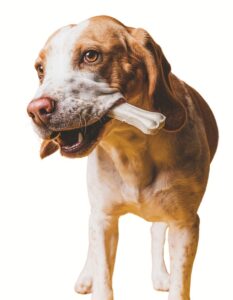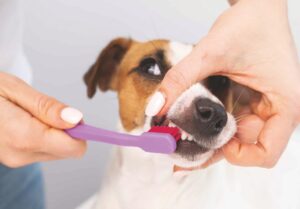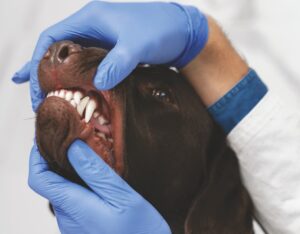Dodging dental dilemmas in dogs
It is estimated that more than 80% of dogs over the age of three suffer from dental problems. Learn more about the progression of dental problems and how you can stop it to keep your pet’s pearly whites safe and healthy!
 Dental issues in pets, especially dogs, is extremely common. Dental disease is commonly referred to as periodontal disease and refers to the tooth plus the surrounding structures. Dental issues in pets start when plaque (combination of food remains + bacteria in the mouth) hardens into tartar (i.e hardened plaque)below the gum line and becomes damaging and infectious to tissue and the jawbone. It is crucial to understand that periodontal disease can be a silent killer as few signs are seen until the disease has advanced. Periodontal diseases can lead to serious health issues beyond bad breath and tooth loss, including kidney, liver and heart damage.
Dental issues in pets, especially dogs, is extremely common. Dental disease is commonly referred to as periodontal disease and refers to the tooth plus the surrounding structures. Dental issues in pets start when plaque (combination of food remains + bacteria in the mouth) hardens into tartar (i.e hardened plaque)below the gum line and becomes damaging and infectious to tissue and the jawbone. It is crucial to understand that periodontal disease can be a silent killer as few signs are seen until the disease has advanced. Periodontal diseases can lead to serious health issues beyond bad breath and tooth loss, including kidney, liver and heart damage.
Dental (or periodontal) health is vital to maintain the overall wellbeing of your furry friends. Without teeth, survival of the animal is particularly challenging. Dogs may succumb to starvation and may require special diets tailored for their chewing needs. Awareness of dental anatomy, disease progression, and dental care options build a foundation for better dental health thus, promoting optimal health of an animal.
Biting into the details and chomping challenges
Periodontal disease has two distinct phases – Gingivitis and Periodontitis.
Gingivitis is the inflammation of the gingiva or gum tissue. Gingivitis is considered reversible with proper care and is called Stage 1 of Periodontal Disease. As gingivitis worsens and bacteria continue to accumulate above and below the gumline, periodontitis occurs. Periodontitis is inflammation of the area surrounding the tooth and is considered irreversible but can be managed through intensive and consistent dental care. You need to lookout for these signs for periodontitis –
![]() Adherence of plaque to the tooth
Adherence of plaque to the tooth- Formation of tartar or calculus (accumulation of plaque) moving below the gumline toward the root
- Inflammation caused by bacteria
If the signs are not detected on time, it can lead to both attachment loss and bone loss (in severe cases). Attachment loss refers to a pocket formed by plaque and tartar moving toward the root of the tooth loosening the tooth. Alongwith attachment loss, the gum tissue from around the tooth also recedes, leading to ultimately bone loss.
Woof away the tooth woes
Plaque migrates from above the gumline to below the gumline, where the underlying structures supporting the tooth become infected. As the infection seeps further in, it allows access of bacteria and its’ by-products to the blood. Via the bloodstream, these harmful bacteria circulate throughout the body affecting the vital organs such as the heart, kidney and liver. It’s important to be able to identify the indicators that your pet is suffering from periodontal disease, which include –
- Bad breath
- Teeth that are discoloured or covered in tartar
- Abnormal chewing or dropping food from their mouth
- Reduced appetite or refusal to eat
- Signs of blood in a pet’s water bowl or on chew toys
- Swelling in the areas surrounding the mouth
- Pawing at the mouth
- Dropping kibbles while trying to eat
- Loose or broken teeth
 Grin and Win –Successfully treating dental problems in canines
Grin and Win –Successfully treating dental problems in canines
If you spot any of these signs and suspect your pet to have dental disease, a veterinarian’s intervention is required. At the clinic the following steps maybe considered to evaluate the severity of the dental disease and to arrive at the treatment protocol – evaluation of the oral cavity for abnormalities; measuring of pockets between the tooth and gum tissue illustrating extend of damage; the removal of plaque and tartar or; the polishing of each tooth to negate enamel damage; irrigation of the structures below the gumline; and the application of anti-plague substances for protection. Dental radiographs are performed as part of the procedure to further monitor structural health below the gumline.
Prevention is always better than cure
Dental care should be a priority starting early in the pet’s life and remaining throughout their adult life. This is the ideal way to prevent the dental worries. Home care consists of brushing your pet’s teeth on a regular basis, giving dental chews daily designed to clean the teeth, or using water additives formulated to interact with water providing some action against plaque formation. The goal of these various preventative methods is to reduce plaque (and tartar if labelled), to freshen breath, and to protect the periodontal tissues from damage caused by plaque accumulation. However, periodic examination by your veterinarian is always recommended.
Toothsome Transformation –Tips to keep in mind
- Vets recommend brushing your pet’s teeth daily or every other day, as plaque can be brushed away easily before it hardens, which takes between 24-48 hours. Start by using a pet-specific toothbrush and toothpaste, which is formulated to taste good to dogs and cats, and includes bacteria-fighting enzymes. Human toothpaste contains ingredients that are toxic to pets and should never be used to brush their teeth.
- If a toothbrush scares your pet, you can ease your pet into becoming more comfortable by first wiping his or her teeth with a pet-safe gauze pad or dental wipe. These options are similar to a toothbrush and are a great way to get your pet comfortable with their teeth being touched.
- Start young. The earlier in life you get your pet accustomed to teeth brushing, the less tedious will be the process for you to manage in the long run.
- Experts recommend regular professional teeth cleanings from a veterinarian, starting at one or two years old, depending on a cat or dog’s size. Your pet will be put under anaesthesia so that each tooth will receive proper attention and care, including under the gum line. These cleanings should be done annually and will include an oral exam to detect any issues or concerns.
 In addition to professional cleanings and an at-home care routine, dental chews are specifically designed to provide dental-related benefits to your furry friends. These treats and chews are meant to remove plaque build-up and often include ingredients that help to clean your pet’s mouth. Many dental treats even freshen breath. Ask your vet to know which dental chews would be best for your pet!
In addition to professional cleanings and an at-home care routine, dental chews are specifically designed to provide dental-related benefits to your furry friends. These treats and chews are meant to remove plaque build-up and often include ingredients that help to clean your pet’s mouth. Many dental treats even freshen breath. Ask your vet to know which dental chews would be best for your pet!
(Dr. Sanjay Awaghate is Vice President – Marketing heading the pet care, pet food, cattle therapeutics and aquaculture segments at Virbac Animal Health India Pvt. Ltd.)


 Adherence of plaque to the tooth
Adherence of plaque to the tooth